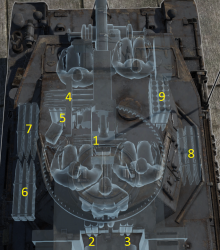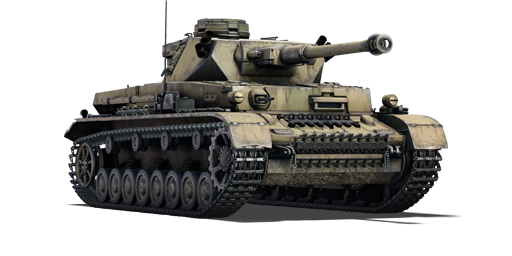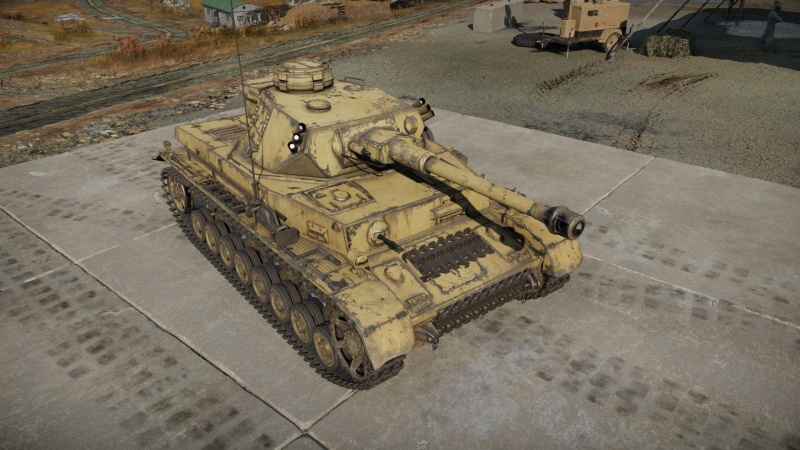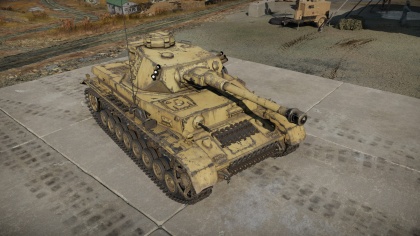Pz.IV G
Contents
Description
The Pz.Kpfw. IV Ausf. G (Pz.IV G) is a rank II German medium tank
with a battle rating of 3.7 (AB) and 3.3 (RB/SB). It was introduced during the Closed Beta Test for Ground Forces before Update 1.41. Compared to its predecessor, the Ausf. G grants a 80 mm front armour plate for increased front survivability, yet retains the same firepower with the 75 mm L/43 gun. The increased armour leads to an increase in weight, which also led to a reduced maximum forward speed.
The Ausf. G variant of the Panzer IV line-up takes the play style of both its predecessor (F2) and successor (H), with the long 75 mm L/43 KwK 40 gun and now a decent 80 mm of frontal armour, good enough to survive encounters with the formidable Shermans and T-34s. It is still light enough to retain a good speed, but well armoured to survive the introduction into Rank III game-play. Due to this, it can perform a variety of play style such as front-line assault, support, and as a flanker.
The most notable external signs of the Panzer IV G compared to its other brothers is the distinctive Dunkelgelb yellow coat on the body, though this will be invalid if it uses an alternate camouflage. In comparison to its successors, the Ausf. H and J, the Panzer IV G has no Schürzen skirts on the turret and hull. Smaller differences are the usage of a double-baffle muzzle brake, a feature that may confuse player for the longer L/48 75 mm gun. There is also the presence of a wheel rack on the left side of the tank holding two wheels (not pictured). Unlike its predecessors and successors, the Ausf. G also comes with smoke launchers on either side of the turret, enabling the tank to defensively saturate an area with smoke; however, unlike launching smoke grenades from inside the tank, all smoke grenades are launched in succession and cannot be launched individually.
General info
Survivability and armour
Armour type:
- Rolled homogeneous armour
- Cast homogeneous armour (Cupola)
| Armour | Front (Slope angle) | Sides | Rear | Roof |
|---|---|---|---|---|
| Hull | 80 mm (11-12°) Front plate 20 mm (73°) Front glacis 80 mm (13-14°) Lower glacis |
30 mm | 20 mm (4-15°) | 10 mm |
| Turret | 50 mm (11°) Turret front 50 mm (7-29°) Gun mantlet |
30 mm (23-26°) | 30 mm (15-17°) | 16 mm Front 25 mm Rear |
| Armour | Sides | Roof | ||
| Cupola | 95 mm | 8 mm |
Notes:
- Suspension wheels are 15 mm thick while tracks are 20 mm thick.
- Lower glacis is protected by attached spare tracks, adding 20 mm of armour
The Panzer IV Ausf. G, despite the improved 80 mm front plate, is still vulnerable to most front shot engagement, especially so if no serious attempt is made in compound angling. The front plate in its unsloped format is an enticing target, but beware to not hit the front sloping glacis right in front of it as that area has a tendency to bounce everything. Also, avoid hitting straight into the ball machine gun and driver's port in the front as these also have a tendency to nullify an armour-piercing shot. When using APHE rounds, simply hit centre mass of the front plate and let the post-penetration effect do the rest.
In the case of a vehicle with a gun simply unable to penetrate this front plate, aim towards the turret that still retains a 50 mm front plate. Even the weaker non-autocannon armaments can penetrate through this front plate and incapacitate the turret crew. Aim for the turret left side (right side when shooting it) to knock out the gunner and deny their firepower, then chip away at weak spots until the threat is destroyed.
Alternatively, aim at the Panzer IV from its long vulnerable sides in cases where its turret traverse cannot keep up with a flanking manoeuvre or catching it in an ambush. The interior is fully stocked with ammo racks even when the user is taking a minimum load. Moreover, the fuel tank resides at the very bottom of the centre of the tank, so a penetrating shot with APHE will either detonate the ammunition, set the tank on fire, or knock out a good portion of the crew, if not fully destroy the tank with all three effects.
In every case scenario, it is to the benefit of the surviving player to fire the first shot against the Panzer IV Ausf. G above all else, as it would deny the Panzer IV G even a chance to use its high-penetrating 75 mm gun.
Mobility
| Game Mode | Max Speed (km/h) | Weight (tons) | Engine power (horsepower) | Power-to-weight ratio (hp/ton) | ||||
|---|---|---|---|---|---|---|---|---|
| Forward | Reverse | Stock | AoA | Stock | Upgraded | Stock | Upgraded | |
| Arcade | 45 | 9 | 23.5 | 0.15 | 465 | 572 | 19.75 | 24.14 |
| Realistic | 40 | 8 | 265 | 300 | 11.25 | 12.66 | ||
Modifications and economy
Armaments
Main armament
| 75 mm KwK40 | Turret rotation speed (°/s) | Reloading rate (seconds) | |||||||||||
|---|---|---|---|---|---|---|---|---|---|---|---|---|---|
| Mode | Capacity | Vertical | Horizontal | Stabilizer | Stock | Upgraded | Full | Expert | Aced | Stock | Full | Expert | Aced |
| Arcade | 87 | -10°/+20° | ±180° | N/A | 13.33 | 18.45 | 22.40 | 24.77 | 26.35 | 7.67 | 6.79 | 6.25 | 5.90 |
| Realistic | 8.33 | 9.80 | 11.90 | 13.16 | 14.00 | ||||||||
Ammunition
- PzGr 39 - Armour Piercing Ballistic Cap shell - This should be the main ammo type, always use this if positive the gun can penetrate enemy armour. It deals the most damage because of its explosive filler.
- PzGr 40 - Armour Piercing Composite Rigid shell - This type of ammo should be used when facing a heavily armored enemy such as the Churchill VII and flanking is not an option. However, its damaging potential is much lower because it has no explosive filler to further enhance damage after the penetration. DO NOT USE PzGr 40 against sloped armor as APCR has extremely poor performance against angled armor.
- Hl.Gr. 38B - High Explosive Anti Tank shell - it is recommended to completely avoid this kind of shell as its performance is vastly inferior in all aspects compared to APCBC or APCR ammo used by this tank.
- SprGr. 34 - High Explosive shell - Carry only very few of these. They are useless against anything other than unarmoured AA vehicles, to which it is lethal.
| Penetration statistics | |||||||
|---|---|---|---|---|---|---|---|
| Ammunition | Type of warhead |
Penetration @ 0° Angle of Attack (mm) | |||||
| 10 m | 100 m | 500 m | 1,000 m | 1,500 m | 2,000 m | ||
| PzGr 39 | APCBC | 137 | 135 | 123 | 110 | 98 | 88 |
| Hl.Gr 38B | HEAT | 80 | 80 | 80 | 80 | 80 | 80 |
| PzGr 40 | APCR | 163 | 159 | 143 | 126 | 110 | 96 |
| Sprgr. 34 | HE | 10 | 10 | 10 | 10 | 10 | 10 |
| Shell details | |||||||||
|---|---|---|---|---|---|---|---|---|---|
| Ammunition | Type of warhead |
Velocity (m/s) |
Projectile Mass (kg) |
Fuse delay (m) |
Fuse sensitivity (mm) |
Explosive Mass (TNT equivalent) (g) |
Ricochet | ||
| 0% | 50% | 100% | |||||||
| PzGr 39 | APCBC | 740 | 6.80 | 1.2 | 14.0 | 28.9 | 48° | 63° | 71° |
| Hl.Gr 38B | HEAT | 450 | 4.40 | N/A | 0.1 | 872.1 | 62° | 69° | 73° |
| PzGr 40 | APCR | 919 | 4.10 | N/A | N/A | N/A | 66° | 70° | 72° |
| Sprgr. 34 | HE | 550 | 5.74 | 0.1 | 0.1 | 686 | 79° | 80° | 81° |
| Smoke shell characteristics | ||||||
|---|---|---|---|---|---|---|
| Ammunition | Velocity (m/s) |
Projectile Mass (kg) |
Screen radius (m) |
Screen deploy time (s) |
Screen hold time (s) |
Explosive Mass (TNT equivalent) (g) |
| K.Gr.Rot Nb. | 540 | 6.2 | 13 | 5 | 20 | 50 |
Ammo racks

| Full ammo |
1st rack empty |
2nd rack empty |
3rd rack empty |
4th rack empty |
5th rack empty |
6th rack empty |
7th rack empty |
8th rack empty |
9th rack empty |
Visual discrepancy |
|---|---|---|---|---|---|---|---|---|---|---|
| 87 | 78 (+9) | 68 (+19) | 58 (+29) | 48 (+39) | 38 (+49) | 28 (+59) | 19 (+68) | 10 (+77) | 1 (+86) | Yes |
Turret empty: 58 (+29)
Machine guns
| 7.92 mm MG34 | ||||
|---|---|---|---|---|
| Mount | Capacity (Belt) | Fire rate | Vertical | Horizontal |
| Coaxial | 3,000 (150) | 900 | N/A | N/A |
Usage in battles
The Ausf. G can be utilized as both a sniper and brawler, thanks to its improved armour and great gun - however, situational awareness must be maintained at all costs as the un-sloped armour, while an improvement over the Ausf. F2 is still not sufficient to provide reliable defence. It is best to shoot first, as the KwK40 L/43 can deal with the majority of enemies it will face. Heavy tanks like the KV and M6A1 will need careful aim but are still not a major threat. Like most German tanks, the default round is the best round available; however, the maximum load should be avoided (around 30 is sufficient) as it increases the chance of ammo rack explosions if the armour is penetrated.
In close quarters/urban settings, it can also perform adequately due to the average turret traverse rate, mobility, and high-punching gun. A good tactic is to launch the smoke grenades and flank enemies that are aware of the Panzer's presence.
The L/43 75 mm KwK 40 gun still packs a powerful punch at this rank. A solid hit on a target's front armour that's not using compound angling is very likely to penetrate. At the battle rating of 4.3, the Ausf. G's worst heavily armoured vehicle it will fight will be the KV series and the M6 heavy tank, both of which have prominent weak spots that can be exploited. Shoot first, hit hard and don't miss.
The Churchill VII is also a common sight in higher rank games. It has thick armour and a gun that is effective against the Panzer's weak turret armour. Under 500 m, it is advisable to use APCR, which is effective against the Churchills flat armour. If the Churchill is angling, the best method is to try flanking or aiming for its weak machine gun ports.
Modules
| Tier | Mobility | Protection | Firepower | |||
|---|---|---|---|---|---|---|
| I | Tracks | Ostketten | Parts | Horizontal Drive | ||
| II | Suspension | Brake System | FPE | Hl.Gr 38B | Adjustment of Fire | |
| III | Filters | Crew Replenishment | PzGr 40 | Elevation Mechanism | Smoke grenade | |
| IV | Transmission | Engine | Add-on Armor | Artillery Support | K.Gr.Rot Nb. | |
Pros and cons
Pros:
- Better armour than predecessors, 80 mm thick at the hull front
- Cupola armour greatly improved to 95 mm thick
- Great gun depression - no need to expose hull when shooting over hills
- High APCR shell velocity (919 m/s) makes targeting moving tanks easy
- Large ammo capacity
- Good mobility on hard ground
Cons:
- Poor ammo storage protection, prone to detonation if penetrated
- Turret front armour is unchanged at only 50 mm thick
- Narrow tracks and quite heavyweight -> Poor cross-country performance - in soft terrain it isn't much faster, or more agile than the heavier Tiger Tank
- Rate of fire is not very impressive
History
Development
The Pz.Kpfw. IV's creation, like its predecessor the Pz.Kpfw. III, was devised by Heinz Guderian. He envisioned a support tank that could be used to handle anti-tank guns and fortifications. In Panzer Divisions, the Panzer IV was to work alongside the more numerable Panzer III (three company of IIIs and one of IVs). The role of anti-armour was reserved for the Panzer III in these situations. As a support tank, the Panzer IV was to have the short 75 mm howitzer as its main armament and also a weight limit of 24 tons. MAN, Krupp, and Rheinmetall-Borsig worked on the development of the tanks, but the Krupp's model was selected for further testing.
The chosen model from Krupp, once finished, used a leaf-spring double-bogie system for its suspension, doing away the proposed interleaved or torsion bar suspension system earlier devised for the sake of faster production. The vehicle held five crew members - the commander, gunner, loader, radio operator (hull machine gunner), and driver. Though it looked symmetrical, the Panzer IV's turret was actually offset to the left of the chassis centre line while the engine was also offset to the right. This was to allow the torque shaft to turn the turret. The offset also meant that most of the ammo was held on the right side of the tank in storage areas. The Panzer IV was then accepted into service and production began in 1936.
Panzer IV Ausf. G
With the appearance of the Soviet T-34 and KV-1 tanks, the Panzer IV Ausf. F2 was made as a stopgap solution with a new and more powerful KwK 40 L/43 gun. After three months into production, the Panzer IV was upgraded again to the Panzer IV Ausf. G. The Ausf. G featured a stronger 80 mm thick front glacis armour with 30 mm side armour. Some weight-saving techniques were put into play, but the tank still weighed about 23.6 tons and put strain onto the driving system. Some simplification went into the tank such as the removal of the vision ports on the sides of the turret.
The Panzer IV Ausf. G was also the first variant on the Panzer IV line to feature some new innovative features. In March 1943, the Ausf. G was presented with the first of the Schürzen side armour skirts on the turret and hull sides. On the later models, the KwK 40 L/43 was also upgraded to the L/48 variant, simply a longer version with a better muzzle brake to improve recoil efficiency.
The Panzer IV Ausf. G was well-liked by the armoured crews due to increased armour and lethality against the progressively stronger Allied armour such as the T-34s and the M4 Shermans. While the 50 mm armour before was deemed very vulnerable to the Allied guns, the 80 mm caused some headaches among Allied tankers, though could still come on-par in performances. At this point, the newer Panther tanks in production should have replaced the venerable Panzer IV by now, but production problems and low quantity meant the Panzer IV was staying at the main tank for the German Army for a while.
The Panzer IV Ausf. G was then upgraded again to the Panzer IV Ausf. H, which would become the most numerous variant of all the Panzer IVs.
In-game description
The first changes of this variant, which were carried out in the summer of 1942, included a new two-chamber pear-shaped muzzle brake. The viewports in the front plates of the turret and the view hatch in its forward plate were removed. Smoke grenade launchers were moved from the rear of the hull to the sides of the turret. The tank was given an ignition assistance system for winter conditions.
Since the 50-mm-thick front armor of the Pz.Kpfw. IV was still inadequate, it was strengthened with additional 30 mm armor plates that were welded or bolted on. The thickness of the front plates on the turret and the weapon mantlet was 50 mm, and this thickness was not increased in future upgrades.
Improving the machines' protective armor during production was a slow process, and by November only about half of the tanks included the reinforced armor. This armor was only installed on all new tanks from January 1943 onward. In the spring of 1943, the 75 mm 7,5 cm KwK 40 L/43 gun on this variant was replaced with a 7,5 cm Kw.K.40 L/48 with a long 48 caliber barrel, which had slightly higher armor penetration power. By the Battle of Kursk, almost all of the tanks had received Schurzen skirts for their sides and turrets.
Production of Pz.Kpfw. IV Ausf. G tanks lasted until June 1943, with a total of 1687 units being produced. Of this number, about 700 tanks received the reinforced armor, and 412 had the KwK 40 L/48 gun installed.
This variant made up the majority of Pz.Kpfw. IV tanks which participated in Operation Citadel.
Ausf. G tanks were supplied to Bulgaria, Romania, Croatia, Turkey, and Spain. The Bulgarian and Romanian machines fought against the Red Army, and after they joined the Allies, against the German military. Captured Pz.Kpfw. IV Ausf. F tanks which were still serviceable were eagerly used by the Red Army.
Media
- Skins
- Sights
See also
- Similar Vehicles
- Pz.IV F2 - German rank II medium tank
- T-34-57 - Soviet rank III medium tank
- M4A2 - American rank III medium tank
- Sherman II - British rank II medium tank
External links
Paste links to sources and external resources, such as:
- topic on the official game forum;
- encyclopedia page on the tank;
- other literature.
| Germany medium tanks | |
|---|---|
| Pz.III | Pz.III B · Pz.III E · Pz.III F · Pz.III J · Pz.III J1 · Pz.III J1 TD · Pz.III L · Pz.III M · Pz.III N |
| Pz.IV | Pz.IV C · Pz.IV E · Pz.IV F1 · Pz.IV F2 · Pz.IV G · Pz.IV H · Pz.IV J · Pz.Bef.Wg.IV J |
| Pz.V | VK 3002 (M) · Panther A · Panther D · Panther F · Panther G · Ersatz M10 · Panther II |
| M48 upgrades | M48A2 G A2 · M48 Super |
| Leopard 1 | Leopard I · Leopard A1A1 · Leopard A1A1 (L/44) · Leopard 1A5 · C2A1 · Turm III |
| Leopard 2 | PT-16/T14 mod. · Leopard 2K · Leopard 2AV |
| Leopard 2A4 · Leopard 2 (PzBtl 123) · Leopard 2A4M · Leopard 2 PL · Leopard 2A5 · Leopard 2 PSO · Leopard 2A6 · Leopard 2A7V | |
| Trophies | ▀M4 748 (a) · ▀T 34 747 (r) |
| Other | Nb.Fz. · KPz-70 |
| USA | mKPz M47 G · M48A2 C |
| USSR | ◊T-72M1 |






